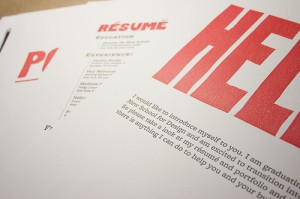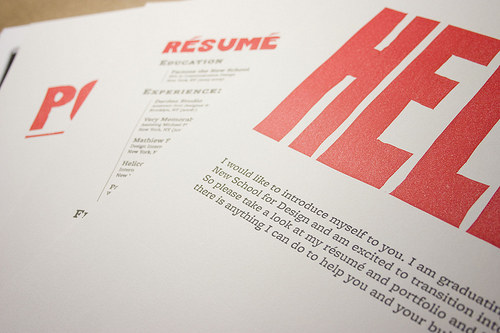 Last weekend, I reviewed about 200 resumes for a client of mine and paid attention to how I decided who would go into the YES, MAYBE and NO piles. I spent a lot of time on this, doing things many recruiters won’t do, because I knew it would give me great information to pass on to you, my readers. The final tally: 30 YES, 55 MAYBE (to review in case the 30 YESes didn’t work out), and 137 NO.
Last weekend, I reviewed about 200 resumes for a client of mine and paid attention to how I decided who would go into the YES, MAYBE and NO piles. I spent a lot of time on this, doing things many recruiters won’t do, because I knew it would give me great information to pass on to you, my readers. The final tally: 30 YES, 55 MAYBE (to review in case the 30 YESes didn’t work out), and 137 NO.
Here’s what I did:
Looked to see if there was a cover letter. The job posting asked for a cover letter and a resume so this was a threshold requirement to see if the applicant read and followed instructions. How I did it: My client used a dedicated Gmail address, so I first did a search for “cover letter” and reviewed those applications first. I realized that people might not have used the term “cover letter” so later I went through all the applications to see if there was a cover letter. Anyone without a cover letter went straight into the NO pile. Just to be sure and to answer all those folks who say “but you might miss a great person that way!”, I did look at every single resume. As I thought, there was no real gem in the pile.
Read the cover letter first. The reason: the position asked for a combination of skills. If applicants mentioned those skills in the cover letter, I knew it was worthwhile to read their resume because I already knew they understood the position to some extent. If they didn’t, I still went ahead and read their resume, but with little confidence that they would have the desired experience; most didn’t. People who didn’t mention the job eventually landed in the NO pile because I saw they didn’t take the time to personalize the letter, and the job requires attention to detail.
A few things made a positive impression on me:
- When people indicated that they knew what the job was and spoke about how their skills would help the organization achieve its goals
- Anyone who showed they knew what the organization actually did, what its purpose is, why it’s important
- Those who said why they wanted to work for the organization and why, especially those who used words like “admire,” “impressed by” or other flattery
- People who used words from the job title and the job description were more apt to get into the “Maybe” or “Yes” pile
- Anyone who said something about their work ethic, work style, experience working with others, getting the job done, or other key values
I actually liked people who said “I looked at your website and was impressed to see xyz.” It was great that it was so direct and out there. I didn’t have to do much work with them – all 2 of them went into the YES pile.
Longer letters also caught my interest not because of all they said but because they had a lot to say about themselves and their relationship to the position and organization. Exception: people who only talked about themselves in the long letter and said nothing about the organization or the job. As I often say, employers care nothing about your past except as you will use it to help us accomplish OUR goals.
Other things I got a negative impression from: typos (with so many applicants, I could afford to relegate those 8-10 people to the MAYBE and NO piles); obvious “fill in the blank with the organization name” form letters – about 10 of those, too; and naming the wrong organization – yes, there were a few of those.
Scanned resumes quickly to see if the applicant had relevant experience and skills. This challenged my speed reading because of the huge variety of formats, fonts and content.
What I liked:
- Chronological resumes. I knew where they’d worked, what they’d done, and the context in which they’d done it. I could see quickly how long they’d been someplace. There were a few functional resumes that frustrated me because I had no idea where they did what they claimed to have done. If you’re going to use a functional resume, at least tell me where you accomplished this fantastic thing.
- Resumes that had accomplishments and impact. Of course, I wanted to know what people did so a description of their activities was great. The people who stood out, however, were the people who knew what difference their work had made to the job or organization. Usually that had some number, percent, or impact word (e.g. “increased” “improved” “reduced”)
- People who listed their skills up front, in a brief list. This is not a functional resume, this is a key word list. This tells me at a glance that the person has the skills I want and need, and predisposes me to read the rest of the resume looking for evidence of those skills. A lot of those people made it into the YES pile. Unfortunately, there were only about 10 of those resumes.
- Those resumes with a summary or profile statement. I noted its presence before I looked at the body of the resume, and then went back to read it. I liked that these few people – about 7 – actually knew themselves well enough to summarize their strengths and abilities, and to tell me something about their values and work ethic. I then got to see if it matched with the employer needs, but it didn’t feel self-serving, like an objective does.
What I hated:
- Too much white space. A waste of space, a waste of my time.
- Functional resumes. Where did you actually become a super-duper such-and-such? Without context, I can’t figure you out and don’t even want to try. Make it easy for reviewers!
- Objectives. I really didn’t care what YOU wanted, only what I was looking for on behalf of my client. If you have to have an objective, state it in the cover letter. Please don’t say “To use my skills in a productive way” as so many did. Well, I would hope so.
- Typos. I don’t understand why anyone would care so little to not have someone proofread. Typos in a resume tell me you don’t really want a job.
Was surprised by a few things. I:
- Paid almost no attention to education. Experience and cover letter strength were more important to me. The exceptions were people who went to my alma mater and mentioned the school in their cover letter. I wanted to like both of them, because I know the quality of education they received. One did get into the YES pile, while the other didn’t because she didn’t have the right experience and was way too pompous in her cover letter. Had she spoken English in her cover letter, she might have made it through simply because of the quality of her education.
- Liked cover letter and resume together in a PDF. A LOT. It was so simple and easy to just scroll through and not have to open two separate files. Less work! The people I really loved? Put the entire cover letter and resume in the email. No clicking of anything else necessary. The only problem there was they didn’t heed instructions. Oh well – these lucky 2 made it through to the YES pile because they had the right experience AND made my life easier.
- Had no trouble finding qualified candidates from all genders, ethnicities, races, ages, and nationalities. What a fantastically diverse pool of applicants! I was delighted to see the range.
- Volunteer experience and internships made a deep positive impression. I was fascinated by how many people had relevant experience from volunteering and being an intern. Those things counted for a lot with me, for they screamed “works hard!” and “willing to do what it takes” – both important attributes for a successful employee.
- Special cases can be effective. One person made the case for himself even though he didn’t have exactly the right skills or background – he was way overeducated and had a lot of irrelevant experience. Normally, I’d say “too senior” or “overqualified.” However, because he made the case for why he’d be good for the job, the skills he brought to the table, and why he wanted the job (to switch fields), I put him in the YES pile.
- Targeted resumes really annoyed me. These were the resumes labeled “Name1_Name2_Resume_OrganizationName” or something similar. Why did I hate it? Because it tells me you want any job and you will tailor your resume to fit the position. I have no idea what you really bring to the table. I don’t know your strengths and skills in general. I only know you are telling me what you think I want to hear. I love a tailored cover letter, but not a tailored resume. If you’re going to tailor your resume, don’t announce it in the name of the document that you send. Unless you send a PDF of both your cover letter and resume.
LESSONS
- Read the job description and make sure you know what the job is and what it requires – and that you have what it takes.
- Research the organization.
- Use the information in your cover letter.
- Send a cover letter.
- Make the case for you as the best fit for the job.
- Flatter the organization.
- Proofread and make sure there are no typos anywhere.
- Use a chronological resume.
- State your impact, not just your responsibilities and tasks, in the resume.
- Have a profile or nothing, just not an objective.
- List your skills up front, briefly.
- Put the cover letter and resume in a single PDF, cover letter first.
Hope this was helpful! I’d love to hear from you if anything in here worked for you.


